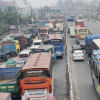Colossal loss
Traffic congestion in Dhaka eats up around 5 million working hours every day and the average speed of vehicles during rush hours has come down to 5kmph, according to the Accident Research Institute of Buet.
The congestion causes an annual loss of between Tk 20,000 crore and Tk 55,000 crore, says ARI, citing findings of organisations working on the issue.
“However, about 50 to 70 percent of the losses can be avoided through proper actions,” ARI Director Prof Moazzem Hossain told a roundtable yesterday.
“Sixty percent of Tk 37,000 crore [half way between Tk 20,000 crore and Tk 55,000 crore] can be saved by those actions,” he said,
Talking to The Daily Star later, Moazzem, a teacher at Buet's Civil Engineering department, said the ARI came up with the estimates analysing available data, including that of Government's Revised Strategic Transport Plan (RSTP) and Dhaka Urban Transport Network Development Study.
ARI and Road Safety Foundation, an organisation working for safe roads and driving, organised the roundtable titled “Traffic Congestion in Dhaka City: Economic and Health Problems” at the ARI building.
In July last year, a World Bank analysis had said in the last 10 years, average traffic speed in Dhaka dropped from 21kmph (kilometres per hour) to 7kmph, which was slightly above the average walking speed.
The speed may drop to 4kmph by 2035, slower than the walking speed, it added.
"Congestion in Dhaka eats up 3.2 million work hours per day. This cost the economy billions of dollars every year," said the analysis.
Citing RSTP, Moazzem told yesterday's roundtable that the people of Dhaka generate 36 million trips per day. Thirty five percent of those are work trips, he said.
Buses are used for 36.97 percent of those trips while rickshaw for 37.69 percent, he said, adding, “The government should give more emphasis on the bus services.”
Around 6,000 buses, including many run-down ones, are currently operating in the capital. It is possible to cater for passengers with even half or less than half of the vehicles, if the system is managed properly.
The transport expert emphasised on forming a separate state-owned company for the regulatory work of the services.
He also said the public transport sector should be run directly by the government and it should give subsidies for the development of the sector.
He also said the government was giving more emphasis on metro rail and similar projects involving costly services, instead of giving that on the cost-effective ones.
ACCIDENTS IN DHAKA CITY
With severe mismanagement in the transport sector, Dhaka is also the worst city in the country in terms of road accidents
Moazzem said 23 percent of the road accidents in Bangladesh took place in city areas. Among the accidents in the city areas, 74 percent took place in Dhaka city alone.
As many as 74 percent of the accidents involved pedestrians, eight percent rickshaws, three percent motorcycles, two percent by-cycles and 13 percent others, he said.
TRAFFIC JAMS
Moazzem mentioned parking on streets; encroachment of arterial or critical junctions by construction work, waste bins or other things; occupied footpaths; competition of buses for passengers; and picking and dropping of passengers anywhere on the road as reasons behind traffic jams.
He gave several recommendations to solve the major problem of the city dwellers.
He said some of the steps should be for freeing footpaths of illegal occupations.
He gave several other recommendations which apparently go with various government policies and required short to long term measures.
Talking about the challenges, he said there were some “obstacles” like pressure from hawkers or beneficiary groups. “We all know who they are…So such matters need to be kept in mind.”
OTHER EFFECTS OF JAMS
Nine categories of human behaviors are related with the transportation issue, said the ARI director, adding that transportation has its impact on issues related to health and safety, social interaction, and perception.
Speaking at the roundtable, Prof Muhammad Siraj-ul Islam, former director of National Institute of Trauma and Orthopaedics, known as the Pongu Hospital, said, “Accidents are not just accidents, rather we create grounds for them and that's why accidents are considered a disease”.
Ninety percent accidents can be avoided by taking proper measures involving road, transport and drivers, he said, adding that traffic jams also cause stress for passengers, leading to their behavioral issues.
Debashis Bardhan, deputy director of the fire service and civil defence, said they faced problems while coming up with quick response to fire incidents and rescue operations due to traffic jam.
In 2017, they rescued 11,500 people in 6500 incidents. Of them, 2500 died on the way to hospital. He claimed that many of those lives could have been saved had there not been any traffic congestion.
He demanded a separate lane for ambulances and vehicles of firefighters.
Dhaka University Economics Prof MM Akash opined that “decentralisation of development” was necessary for stopping people from crowding the capital.
Kazi Md Shifun Newaz, assistant professor of ARI, said several government organisations were working on the issue, “But, I think there is a lack of coordination among them”.
Buet Prof Sarwar Jahana and DU teacher Farah Deeba also spoke at the programme which was chaired by Road Safety Foundation Chairman Prof AI Mahbub Uddin Ahmed and moderated by its vice-chairman Jyotirmoy Barua.

 For all latest news, follow The Daily Star's Google News channel.
For all latest news, follow The Daily Star's Google News channel. 







Comments